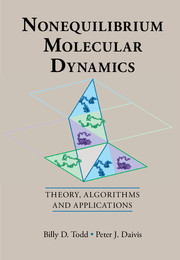Book contents
- Frontmatter
- Contents
- Preface
- 1 Introduction
- 2 Nonequilibrium Thermodynamics and Continuum Mechanics
- 3 Statistical Mechanical Foundations
- 4 Temperature and Thermodynamic Fluxes
- 5 Homogeneous Flows for Atomic Fluids: Theory
- 6 Homogeneous Flows for Atomic Fluids: Applications
- 7 Homogeneous Heat and Mass Transport
- 8 Homogeneous Flows for Molecular Fluids
- 9 Inhomogeneous Flows for Atomic Fluids
- 10 Confined Molecular Fluids
- 11 Generalised Hydrodynamics and Slip
- Bibliography
- Index
9 - Inhomogeneous Flows for Atomic Fluids
Published online by Cambridge University Press: 30 March 2017
- Frontmatter
- Contents
- Preface
- 1 Introduction
- 2 Nonequilibrium Thermodynamics and Continuum Mechanics
- 3 Statistical Mechanical Foundations
- 4 Temperature and Thermodynamic Fluxes
- 5 Homogeneous Flows for Atomic Fluids: Theory
- 6 Homogeneous Flows for Atomic Fluids: Applications
- 7 Homogeneous Heat and Mass Transport
- 8 Homogeneous Flows for Molecular Fluids
- 9 Inhomogeneous Flows for Atomic Fluids
- 10 Confined Molecular Fluids
- 11 Generalised Hydrodynamics and Slip
- Bibliography
- Index
Summary
So far we have largely considered NEMD simulation methods for fluids undergoing homogeneous flows. The exceptions to this were the “method of planes” and volume averaging techniques, in which expressions were derived that allow us to compute densities and fluxes for inhomogeneous fluids for various geometries (see Chapter 4). In this chapter we will use some of these expressions to compute relevant properties of highly confined fluids under several different flow conditions. In addition, we will show how to implement appropriate equations of motion to faithfully model fluids subject to spatially periodic fields and fluids under extreme confinement. It is with the latter application in mind that NEMD techniques are particularly important in the field of nanofluidics.
For over 150 years classical Navier-Stokes hydrodynamics [315] has been a wonderfully successful theoretical tool for predicting the properties of fluids and gases under a large variety of conditions. Its success extends from describing the dynamics of galactic motion [316], the aerodynamics of flight [317], the hydrodynamics of substances from liquid water to dense polymer melts [28], and right down to the flows of fluids on the microscale [318, 319]. It has even been shown to be accurate down to nanoscale dimensions [96], as long as certain conditions are maintained. In a numerical study on the Lennard-Jones fluid, it was first clearly demonstrated that, for an atomic fluid confined by atomistic walls, the Navier-Stokes equations were valid down to confinement spaces as low as around 5 to 10 atomic diameters [96, 320]. Below this spacing the fluid becomes highly inhomogeneous in space so the assumptions of constant density, constant viscosity, etc. break down, as do the Navier-Stokes equations.
At such small length scales another significant problem arises: the transport properties of fluids become nonlocal in nature. Although this effect has implicitly been built into the theory of generalised hydrodynamics [321] (see also Chapter 11) it has only recently been validated when the spatial extent of variations in the velocity gradient of the fluid are of the order of the width of the viscosity kernel [322]. The kernel itself is a nonlocal material property of the system with both wavevector and frequency dependence [321, 323] and has been accurately computed and parameterised for the Lennard- Jones fluid [324].
- Type
- Chapter
- Information
- Nonequilibrium Molecular DynamicsTheory, Algorithms and Applications, pp. 266 - 293Publisher: Cambridge University PressPrint publication year: 2017



